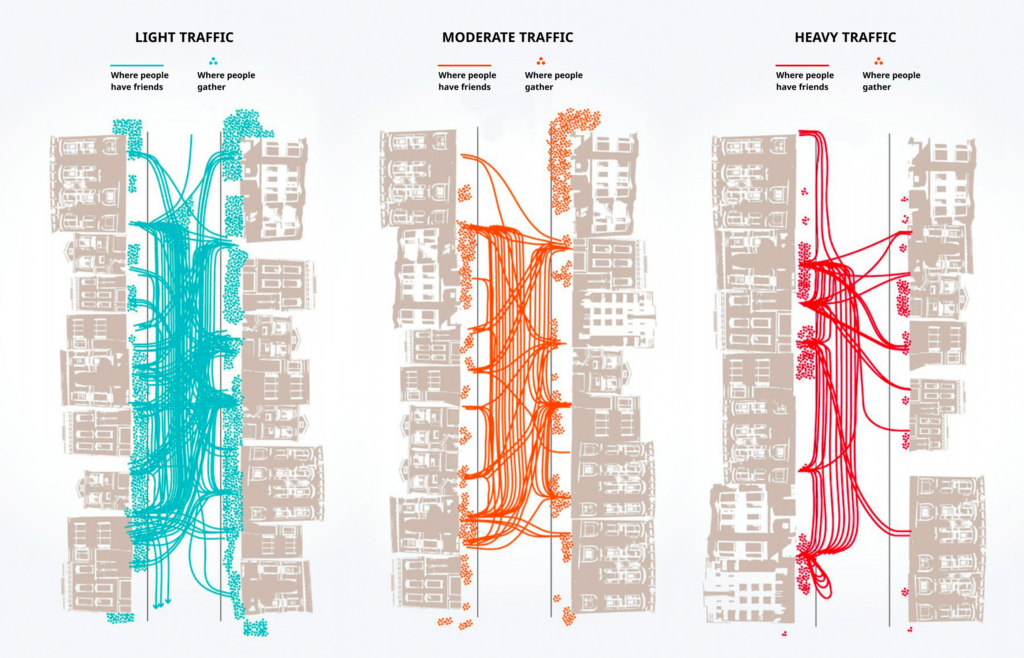While I was listening to various scientific podcast episodes of DDCAST for another university module, I came across a very interesting approach on how to ensure more sustainability within urban planning, both on an environmental and social level. In the interview, Janina Albrecht mentions various approaches to tackling the issue.
Urbanization has a significant impact on our lifestyle. Transport planning in urban areas in particular has a lasting impact on the quality of our life. But how could a redesign of urban transport infrastructures drive a future-oriented, people-centered transport transition?
Currently, car-centric cities dominate, primarily focused on accelerating car traffic while excluding other road users. A growing discussion on both an environmental and social level is striving for cities that offer more space for interaction, individual development and diverse lifestyles. The design of transportation infrastructure in cities therefore needs to be comprehensively rethought to create a more liveable environment for all.
The overall aim is to identify strategies for redesigning transportation infrastructure to create an inclusive and liveable urban environment. In the long term, this should lead to a sense of well-being, respect and an improved quality of experience for all residents.
The problem is, that current city design separates people from each other. Graphics such as the one by Donald Appleyard (1980) illustrate that a reduction in car traffic increases the likelihood of interaction and human encounters. On the other hand it also shows that the more car traffic there is on the streets, the less interaction happens between the citizens.

Way in the past, the street was a social hub, whereas today it mostly has a purely traffic-oriented function. A redesign of urban spaces should therefore restore opportunities for social interaction and encounter.
To develop solutions for effective redesign, a detailed analysis of existing urban spaces and consideration of the needs of different road users should be done. A low-threshold approach that visualizes new perspectives and gives people the opportunity to get actively involved is essential.
Therefore there should be created activities that arouse curiosity and create irritation and thus attention.
Janina Albrecht was also talking about the results of some public research that was conducted, which shows that public spaces are not quite designed for the human use. Whilst public spaces always have rectangular structures, the analysis of human behavior/traces shows, that they are round and smooth. This leads to a tension with reality.
She also is aware of the fact, that currently it is hardly possible to unite car and bicycle traffic, which is why the two are still separated most of the times.
But she also mentions that we already got strategies that work well for a car-centered city and that these exact strategies can be used to make cycling and walking more user-friendly.
Concluding it is important to be aware that a redistribution of urban spaces can improve the quality of life by promoting diverse use of transportation and increasing the safety and well-being of residents a lot. A long-term vision is to integrate all road users into the development of urban spaces in order to create a more harmonious coexistence.
Also the social acceptance of new concepts is a very important step. Solutions should take into account diverse perspectives and requirements and be implemented gradually, building on one another. Successful design includes the integration of green spaces, shaded areas, barrier-free paths and balanced access to different modes of transportation such as public transport and safe cycle paths.
References
(1) Albrecht, J., & Bertsch, G.-C. (o. J.). DDCAST 13—Janina Albrecht „Die Stadt vermenschlichen“ (13). https://open.spotify.com/episode/3CFljymuME6gznnWp23Ein?si=1d7ccea67f884786
(2) Appleyard, D. (1980). https://useruploads.cdn-decorrespondent.nl/image/o0-h4m0KqFUDWNpGddNKbIUATFU=/904×1528/dc-useruploads-images/e2a875cc44d44330ba75c44b6f32fe50.png